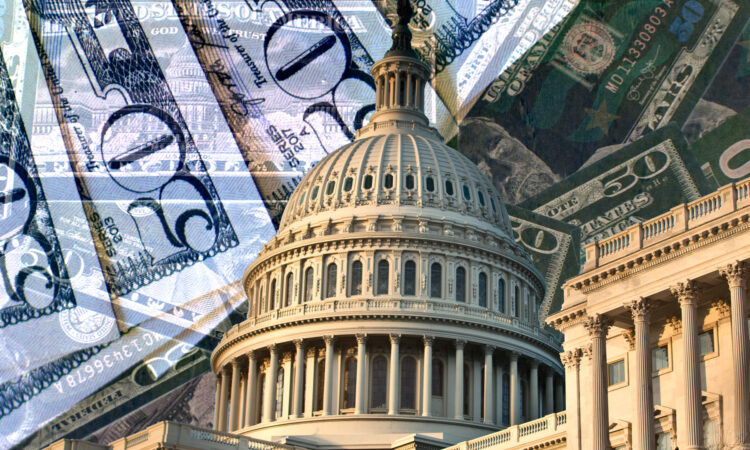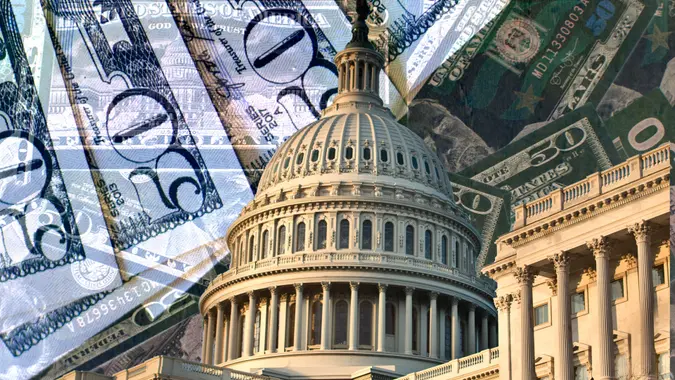

Douglas Rissing / Getty Images/iStockphoto
The U.S. just hit its debt limit, following Congress’s failure to reach a deal to raise the debt ceiling. While the Treasury Department announced it would start implementing its “extraordinary measures” — including suspending retirement and health benefit funds — which will in essence just buy time, but not resolve the issue.
Debt Ceiling 2023: How Federal Deficit and National Debt Differ
Learn: Get Your Credit Score On Track With These 3 Tips for Success
Discover: Do You Have Too Much Money in Your Checking Account?
To put this in context, the debt limit was raised to approximately $31.381 trillion on Dec. 16, 2021, but a Republican-led Congress following the midterm elections is now looking for spending cuts in exchange for support in raising the debt ceiling, something most Democrats argue against.
Meanwhile, consumer credit card debt is also at an all-time high. The average debt of Americans with unpaid credit card balances is $6,569 and Americans’ total credit debt is up to $887 billion, a 13% increase from the second quarter of 2021 — the largest year-over-year jump in 20 years, according to a recent Spinwheel survey.
“Without enough money to pay its bills, any of the payments are at risk, including all government spending, mandatory payments, interest on our debt, and payments to U.S. bondholders. While a government shutdown would be disruptive, a government default could be disastrous,” the CFRB noted.
“In the simplest terms, the federal debt ceiling is a lot like your credit card bill. The debt ceiling is your balance — both you and the federal government have already charged a bunch of expenses. Now it’s time to pay. You write a check, but the federal government needs the House of Representatives to take formal action,” said Howard Dvorkin, Howard Dvorkin, CPA and Chairman of Debt.com.
Dvorkin added that Congress is grappling with two separate issues here: The United States can’t keep spending more than it earns, because eventually, that catches up with both you and the country.
“But you don’t fix your budget by refusing to pay for stuff you’ve already bought. You just ruin your credit score and your reputation. The United States is facing that same scenario if it doesn’t raise the debt ceiling,” he added.
Let’s take a look at the consequences of overspending for the government and for individuals, and see why the government can get away with high levels of debt when the average American cannot.
Student Loan Forgiveness: Timeline of Events Leading Up To the Supreme Court Review
What’s the Difference Between Credit Limits and Debt Limits?
When the U.S. fails to increase its debt limit, that means that it does not authorize new spending commitments, but allows the government to finance existing legal obligations that congresses and presidents of both parties have made in the past, according to the Treasury. In other words, it’s akin to having pending charges on a credit card, with no sufficient funds to cover them, and asking your financial institution for an increased credit card limit. This would not allow you to make additional charges — it would only allow you to cover existing ones.
Tomas Campos, co-founder and CEO of Spinwheel said, one of the starkest differences between government and personal debt is that when a government spends more, that doesn’t always mean more debt.
“If current economic pressures persist that the country faces now — rising inflation, increasing interest rates and the continued threat of recession – Americans are going to feel the pinch and likely take on more personal debt,” said Campos. “It’s clear folks are in dire need for better solutions to manage personal debts — especially credit card and student loan debt, and even the rising popularity of novel solutions like [Buy Now, Pay Later].”
In contrast, there are several negative consequences for consumers who do hit or go over their credit card limits. First, any charges attempted will be declined. In addition, you might incur additional fees and have your credit limit lowered or your interest rate increased, as GOBankingRates previously reported.
“Growing debt over time can push people, companies, and governments into a fiscal death spiral,” said Bob Armour, chief marketing officer at M1 Finance. “If more income goes to paying debt service, there’s less left over to maintain lifestyles or productivity or profitable investments. If someone (or an entity) doesn’t break their reliance on debt by cutting overall spending, the cycle gets worse as the new debt is more expensive than the debt that exists. The debtor ends up in an ever-increasing precarious place, and if left unaddressed, ultimately bankrupt and/or unable to continue to operate.”
Find Out: Want an 800 Credit Score in 2023? LendingTree Analyzed How To Do It
How Does the US Credit Score Compare to Your Personal One?
An additional potential effect of reaching a credit limit is that it might lower your credit score (or the government’s), which in and of itself might trigger another set of issues.
In one worst-case scenario, the failure to reach a deal could trigger a rating downgrade, as happened in August 2011, when the S&P stripped the country of the AAA rating it had held for 70 years, to AA+, “a score that ranks below more than a dozen governments’, including Liechtenstein’s, and on par with Belgium’s and New Zealand’s,” the Wall Street Journal said at the time.
And if no deal is reached after the “extraordinary measures” Yellen has taken expire sometime in June, that could potentially trigger a default, which occurs “when the Treasury does not have enough cash available to pay for obligations that have already been made,” according to the Committee for a Responsible Federal Budget (CRFB).
“Your payment history is the most important factor in your credit score,” said Ted Rossman, senior industry analyst CreditCards. Com. “Next is how much you owe. An important component of this category is your credit utilization ratio: credit you’re using divided by credit available to you, especially on credit cards.”
“Many people don’t realize this ratio is usually calculated on your statement date, so even if you pay in full and avoid interest, you might have a high utilization ratio if you use the card a lot,” he added, suggesting that good fixes include making an extra mid-month payment and/or requesting a higher credit limit.
Discover: 6 Strategies for Paying Off Multiple Credit Cards
What Happens to Purchasing Power if Debt Limits Aren’t Raised?
In a Jan. 17 article, the Bipartisan Policy Center reported that U.S. debt is frequently viewed by global financial markets as one of the safest assets in the world. However, if that debt starts “being priced based on our nation’s willingness to pay its bills rather than its ability to pay, the ramifications could range from short-term market confusion to long-term economic damage,” the Center noted.
“If the government did not meet its expectations — simply put, borrowing money would get more expensive, just like any individual who doesn’t meet their financial obligations and their credit score goes down,” said Rebell. “For example, ratings agencies would likely issue downgrades, and that would make it more expensive for the U.S. government to borrow. That could in turn be passed on to consumers through higher rates for things like mortgages and other types of consumer debt that are linked to the U.S. Treasury market.”
Basically, purchasing power means how far your money can go and it can be affected by various factors including inflation and interest rates. And in the current economic landscape — which has a combination of both — consumers should be even more careful about overspending and taking on more debt.
CreditCards.com’s Rossman said that what’s most important for everyday people is to consider the total cost of ownership. “How much debt are you taking on? What’s the interest rate? How long is the term? Is this good debt (or at least less bad debt) because it’s going to improve your financial standing in the long run, or are you running the risk of getting trapped in an expensive debt cycle because you bought something more discretionary on credit,” he said.
Take Our Poll: What Are Your Financial Priorities in 2023?
Why Does the U.S. Government Take On New Debt without Paying Off What’s Due?
“Adding to the national debt is a classic case of using what should be a short-term solution to fix what has and continues to be a long-term issue. The consequences to the U.S. economy can be serious. Treasury Secretary Janet Yellen has warned that hitting the debt ceiling may ’cause irreparable harm to the U.S. economy, the livelihoods of all Americans, and global financial stability,’” said Bobbi Rebell, CFP, Founder Financial Wellness Strategies and author Launching Financial Grownups.
She added, for individuals, constantly taking on new debt is a dangerous cycle that can turn a band-aid fix into a downward spiral of debt that can impact their current and future financial health.
For the government, the risk is necessary since not spending the money has immediate consequences on people’s jobs and livelihoods, on national defense, on social security payments and ultimately on the financial system itself, Brad McMillan, Chief Investment Officer, Commonwealth Financial Network points out.
“U.S. government debt is the ultimate low-risk asset. And if it doesn’t get paid? Then the whole financial system could be rocked. If the U.S. government chooses not to meet its obligation, that will rock both the economy and the markets. So, if that were to happen, there would be real risks and we should be watching them,” he said, adding: “But will that happen? Probably not.”
More From GOBankingRates
Source link






